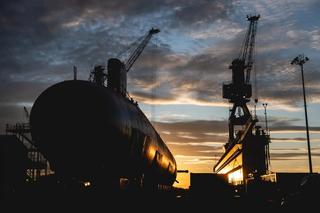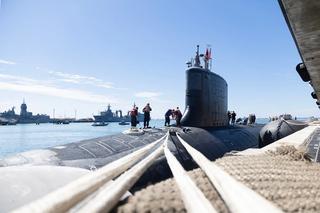About this report
This report reflects anonymised insights from a Track 1.5 dialogue convened by the United States Studies Centre (USSC) in February 2025, which brought together more than 70 senior representatives of the Australian federal and state governments, major industry organisations, universities, unions, media and academia. Attendees included the global leadership of organisations with 70 years of experience in nuclear industry. The discussion focused on ongoing implementation challenges facing Australia in the delivery of the AUKUS nuclear-powered submarine program and reflections on the experiences of Australia’s AUKUS partner countries.
Recommendations
The following principles should be at the centre of ongoing efforts by the Australian federal and state governments — led by the Australian Submarine Agency — to implement the AUKUS submarine project, in light of prevailing functional, workforce and public opinion challenges. These principles are informed by proposals and concerns raised by dialogue participants during a February 2025 conference.
Delivering a nuclear project
- Undertake disciplined and detailed forward planning, manifested in early investment, that connects acquisition with execution.
- Develop effective interfaces to streamline government-to-industry interactions and ensure a high level of customer group engagement.
- Demonstrate technical and legal practice necessary to earn national and trilateral confidence in the operation of Australia’s nuclear regulator.
- Determine a regularised, accessible and purposeful means to engage with the wider ecosystem of stakeholders involved in program delivery.
- Leverage Australia’s AUKUS partners to grow competency and economic viability across all lines of effort.
Developing a sovereign workforce
- Put policy enablers in place to embrace an interchangeable AUKUS workforce.
- Share information comprehensively among AUKUS partners to learn best practices and develop collaborative training models.
- Create incentives for prospective students and apprentices to participate in Australia’s AUKUS enterprise.
- Cultivate a value proposition to prospective AUKUS workers that extends beyond remuneration.
- Increase the fluidity between industry and government workforces to improve expertise and capacity to work together.
- Prepare training models and financial plans to weather future disruptions in the AUKUS workplan.
Building confidence among the Australian national community
- Substantiate the Government’s assertion that AUKUS is a national endeavour by engaging stakeholders across Australia’s states and territories.
- Demonstrate competence and answer public concerns about nuclear safety and the environment.
- Make a sovereign strategic case for AUKUS capabilities to the public.
- Sustain high-level political leadership across all three countries.
- Proactively engage with the full ecosystem of industry and local stakeholders to improve public literacy and pre-empt areas of concern.
- Provide sufficient direction and investment to support local community leaders’ engagements on AUKUS.
- Celebrate AUKUS successes nationally and internationally.
- Consistently assert and showcase the benefits unlocked for each AUKUS nation by trilateral cooperation.
Introduction
Three years after its announcement, significant progress has been made to realise the Australia-United Kingdom-United States (AUKUS) partnership on nuclear-powered submarines. In early 2025, the Australian Government took further steps along the announced ‘Optimal Pathway’ to lend additional substance to the pact, from the unveiling of the AUKUS Submarine Industry Strategy in March1 to the announcement of the first of Australia’s six A$800 million investments into the US industrial base during Australian Defence Minister Richard Marles’ February meeting with US Secretary of Defense Pete Hegseth.2 Some 100 Australians are also currently undergoing nuclear training in AUKUS partner countries.3 Unsurprisingly, due to its cost and ambition, the project consumes the headlines of major mastheads and public discussion in Australia.4
An ambitious timeline lies ahead for the AUKUS partners. US Virginia-class submarines will begin rotating out of HMAS Stirling in two years, beginning with one and increasing to four. An additional deployment of one British Astute-class submarine will increase this rotational force to five. By the early 2030s, Australia is slated to arrive at a point of “sovereign readiness” to safely own, operate, maintain and regulate a nuclear-powered submarine fleet. This milestone will be marked by the transfer of two used US Virginia-class submarines and the sale of a third submarine off the US production line. In the 2040s, Australia will build the SSN-AUKUS based on a UK design with US technical inserts.
Though significant energy is being exhausted at the federal and state levels to deliver this complex industrial partnership with requisite urgency, it is difficult to overstate the scale of the enduring challenges.
Though significant energy is being exhausted at the federal and state levels to deliver this complex industrial partnership with requisite urgency, it is difficult to overstate the scale of the enduring challenges. Australia is only the seventh country in the world to acquire SSNs.5 It is the first country to do so without a civil nuclear industry and the first to do so without an arsenal of nuclear weapons. The fact remains that there is no precedence for this project domestically or internationally.
Accordingly, each phase of implementation must be subject to scrutiny and review. The Australian Submarine Agency (ASA) is poised to update its planning and processes continually. Already, the agency commissioned a review from a private consultancy last year to transition the agency from crafting enabling policy to delivering the submarines themselves. Deputy Prime Minister Marles has also commenced his own review of AUKUS progress.6
To this end, the USSC convened a Track 1.5 dialogue of senior stakeholders in the AUKUS enterprise to invite experts’ critical analysis of Australia’s AUKUS efforts. Reflections from attendees are organised by, arguably, the three most significant ongoing challenges facing Australian policymakers: delivering a nuclear project (including the infrastructure and regulatory frameworks necessary to underpin it); developing a sovereign workforce; and engaging in public debate to secure the social license essential to sustaining the enterprise.
1. Delivering a nuclear project
Though Australia has a long track record of delivering ambitious infrastructure projects, the AUKUS submarine program stands out for its scale, complexity and the nuclear component at its centre. Australian states governments and industry are broadly confident about their ability to deliver the necessary infrastructure rapidly on the condition of clear project ownership, clear functional requirements and a clear procurement plan. That said, senior representatives from government and industry agree that a nuclear project will require a fundamentally different approach than has been used for previous major infrastructure undertakings. These experienced practitioners remarked that the failure of a nuclear project very rarely arises from any serious technical issue. Instead, they warn that most cost overruns and delays are the result of strategic management failures.
Australia brings several national advantages to the AUKUS project. Decades of operation of the Australian Safeguards and Non-proliferation Office (ASNO), Australian Radiation Protection and Nuclear Safety Agency (ARPANSA) and the Australian Nuclear Science and Technology Organisation (ANSTO) have given Australia a small but proficient nuclear industry. To date, these organisations have ensured that Australia maintains a flawless record for the safe and secure management of radioactive waste. To rise to new regulatory and management challenges presented by the AUKUS program, the ASA is also doing a significant amount of work with the International Atomic Energy Agency (IAEA) and with its AUKUS counterparts to ensure Australia upholds its international treaty obligations and guarantees its fitness to meet additional rigorous technical safeguards.7

Among the Australian Government’s most significant priorities, two near-term initiatives are currently maturing that will underwrite the future success of AUKUS: comprehensive planning and coordination within the Australian cross-government organisation; and the establishment of Australia’s nuclear regulator. On the first, ASA personnel are determining the best processes and practices to collaborate with their state-level counterparts, mapping workforce requirements across the supply chain, and developing a competency framework for workforce development. On the second, following an independent review, Australia’s officials and many existing regulators are configuring Australia’s sovereign approach to regulation; the Australian Nuclear-Powered Submarine Safety Regulator should be formed at the government’s discretion and commence operations in late 2025.8 Consistent with and complementing these efforts, attendees agreed that several conditions must be met to realise a successful nuclear project like AUKUS. Those conditions are the following:
a. Undertake disciplined and detailed forward planning, manifested in early investment, that connects acquisition with execution.
In standing up Australian SSN construction and maintenance, the ASA must embrace the long-standing truism of ‘going slow to go fast.’ While the government should avoid reinventing the wheel where possible, the idiosyncrasies of AUKUS demand new approaches rather than embracing past acquisition solutions ill-suited for the novel demands of a nuclear project. Australians must heed the lesson that US naval projects have failed or struggled in the past due to the decoupling of their different phases. An arbitrary separation of these components is evidence of poor forward planning and creates issues with nuclear safety, classification and interfaces, among other areas. In the case of AUKUS shipbuilding, participants flagged that early integration of construction with the operators should be a feature of planning, as it can ensure problems are anticipated and designed out in the early phases of the project.
In the United Kingdom, a failure to assign long-term funding and plan against future windows of underutilisation has unleashed significant run-on effects on its submarine industrial base. The AUKUS Submarine Industry Strategy rightly identified industry’s uncertainty of demand as a major impediment to AUKUS progress.9 Program stability should be front-of-mind in configuring timelines and work requirements and early investments should continue to provide confidence to industry partners. The long timeframes of AUKUS work make setting a realistic budget inherently challenging, but the Australian Government must conduct regular and comprehensive reviews. Infrastructure is among the areas most prone to cost blowouts in the early phases of a major defence project. To this end, dialogue participants across sectors endorsed the ASA’s demonstrably heavy emphasis on proceeding with caution in this early phase of the AUKUS project and were willing to be patient on announcements.
b. Develop effective interfaces to streamline government-to-industry interactions and ensure a high level of customer group engagement.
After three years, AUKUS has begun its transition from a tightly held government-to-government project to one that is proceeding largely government-to-industry, marked by the announcement of industry build and sustainment partners and the signing of the AUKUS mobilisation deed.10 Still, work remains to optimise engagements between the ASA and its partners and to appropriately share risks. Sustained, strategic political leadership across the Australian delivery agencies is a pre-condition for success. The government should be critically engaged at each point of the project, and collaborative in resolving resourcing and budget issues. This is crucial not only to improve outcomes but also to minimise fear of failure. Industry representatives recommended that project risks must be assessed and held at the strategic level, rather than abdicated to others in the supply chain who lack the ability and influence to manage these risks.
Industry representatives recommended that project risks must be assessed and held at the strategic level, rather than abdicated to others in the supply chain who lack the ability and influence to manage these risks.
c. Demonstrate the technical and legal practice necessary to earn national and trilateral confidence in the operation of Australia’s nuclear regulator.
Australia’s approach to ‘nuclear stewardship’ needs to inspire such confidence that it earns and maintains far-reaching social license, both from the Australian stakeholders involved in AUKUS delivery and from Australia’s AUKUS partners. Australia’s efforts to grow community confidence should be informed by the historical performance of both the United Kingdom and United States, who have long operating nuclear capabilities without incident. Different regulatory authority regimes will require assurances that the reactors remain safe under all conditions, in particular in the provision of cooling water, power supplies and when confronted with environmental disasters.11 This will require clear role clarity and straightforward communications with industry to best convey what compliance means in practice. It should be acknowledged that Australia’s regulatory approach will be distinct from those of its AUKUS partners, both due to Australia’s long-standing preference for responsive regulation already codified by parliament and by virtue of the dynamism demanded by operating US and then UK-designed nuclear-powered capabilities consecutively under the ‘Optimal Pathway.’ Australia’s partners will need the political willingness to trust Australia’s sovereign operations. One partner remarked that at a certain point, “Americans need to leave our ego at the door so that Australia can carry on.”
d. Determine a regularised, accessible and purposeful means to engage with the wider ecosystem of stakeholders involved in program delivery.
Given the complexity of the project and ambition of the timeframes, it is critical for AUKUS implementation that all stakeholders have common understandings of near and long-term objectives. The challenge of undertaking that communication is immense, given the vast number of people that will be involved across Australia’s states and territories. Indeed, one participant quipped that “it seems that there are 25 million people in Australia but 50 million submarine experts.” Repeatedly throughout the dialogue, participants expressed the importance of putting those responsible for delivery across sectors into one room, to the extent possible. Some suggested that engagement challenges have been accentuated by the federal government’s reticence to share ownership of the enterprise with industry, though they acknowledged this is beginning to abate. A “teaming culture” must be developed to cohere these unstructured groups, as clashing professional cultures stand to derail that cooperation. Clarity on roles and responsibilities within the AUKUS shipbuilding enterprise is viewed by stakeholders from all sectors as critical to minimise duplication of effort and ensure accountability when costs or timelines deviate from expectations.
e. Leverage Australia’s AUKUS partners to grow competency and economic viability across all lines of effort.
AUKUS is distinguished from other international partnerships by the three countries’ commitment to systemic trilateral cooperation across broader industrial priority areas, rather than limiting the pact to the mere transfer of arms to Australia. This ethos is embodied in the blanket — rather than AUKUS-specific — exemptions the United Kingdom and Australia received to the US International Traffic in Arms Regulations (ITAR) in November 2023. Under a Trump administration in Washington far more sceptical than its predecessor about the importance of empowering its allies, it will be more important than ever for the Australian Government to emphasise the two-way benefits of AUKUS collaboration beyond the transfer of US submarines. Currently, the three countries are effective in this regard; the ASA are shadowing Virginia-class submarines to learn how to practice governance and technical operation and Australian submariners are graduating from US nuclear training academies.12 In particular, participants embraced officials’ efforts to certify and advance Australian SMEs’ contribution to US supply chains, including through the Defence Industry Vendor Qualification Program. Such efforts will benefit the United States while providing commercial and training opportunities to Australian companies ahead of sovereign submarine construction.
The final condition partners underscored, as affirmed by the AUKUS Submarine Industry Strategy, is the need to grow an Australian technical workforce with the requisite fluency and experience in nuclear operations. Australia-specific workforce development challenges and associated policy recommendations are outlined in the following section. The Australian Government and its partners in the defence industry, technical colleges and the university sector must deliver a robust and specialised training program for workers to operate in a nuclear secure environment. Critically, that nuclear skills pipeline must also contribute workers into the supply chain as well as into the enterprise itself. The talent pipeline must mature well ahead of construction to build both workers’ expertise and AUKUS partners’ confidence. During the early design phases and right through construction, there should be a symbiotic relationship between the manufacturers, infrastructure designers, and the end users, so future challenges are proactively identified and designed out.
2. Developing a sovereign workforce
It is impossible to deliver any major project in the absence of a cohort of ‘suitably qualified and experienced people’ — SQEP, as they are referred to in the United Kingdom. For a nuclear project, such skills are challenging to deliver on short notice or to reacquire after a period of stalled work in the future. AUKUS requires both a policy and industrial workforce with knowledge extending from detailed analysis to integration to procurement to production and beyond. Accordingly, workforce development initiatives have been a key ASA policy focus over the past four years, which itself is expanding to more than 650 employees by the end of FY2025.13 The government is investing A$480 million in the Skills and Training Academy in Osborne.14
Still, the fact remains that an inability to realise a suitably skilled workforce at the scale required remains the single biggest risk factor for AUKUS’s success. Australia faces skills shortages in 36% of AUKUS occupations, including in 50% of technical and trade areas like construction.15 The extent of growing workforce demands in adjacent sectors (e.g. resources, renewable energy, and surface shipbuilding), as USSC experts have previously examined, forebodes fierce competition for the AUKUS submarine industrial workforce.16 Such is the challenge of developing a labour force of sufficient scale and expertise that recruitment and retention efforts remain pace-setters for UK and US submarine production lines, even decades after establishment. Workforce shortages are endemic to the US submarine industrial base, with the gap between procured boats and the number built growing in recent years as a small workforce struggles to keep pace with surging demand. The need to remain competitive in attracting a limited pool of talent is among the key factors driving US shipbuilding costs up by 20% in recent years.17 Similarly, the United Kingdom’s First Sea Lord has, in recent years, described a “war for talent” in the Navy and industrial base.18
The fact remains that an inability to realise a suitably skilled workforce at the scale required remains the single biggest risk factor for AUKUS’s success. Australia faces skills shortages in 36% of AUKUS occupations, including in 50% of technical and trade areas like construction.
At the same time, though US and UK workforce challenges introduce poaching concerns, they equally inspire creative collaboration. In recent years, the US and UK industrial bases have experienced some real successes in retaining workers and delivering increased scale. For instance, the Newport News Apprentice School located in Virginia receives 3,000 applicants for just 150 slots and retains 80% of the apprentices it trains after 10 years.19 Already, the three countries are coordinating and sharing information on skills and training initiatives, to an extent. A flurry of senior officials and industrial personnel traveling to training sites has occurred since the ‘Optimal Pathway’ announcement. However, much remains to be done to regularise and expand both mobility programs and information exchange to the benefit of all three countries. Conditions for future success in workforce development at the tri-national and Australian levels are the following:
a. Put policy enablers in place to embrace an interchangeable AUKUS workforce.
An AUKUS visa or a digital ID are policies that experts, including in previous USSC publications, have advocated for shortly following the initial AUKUS announcement and which continue to earn the endorsement of key stakeholders.20 A digital ID, for instance, would contain a trained worker’s skills, credentials and clearance in one AUKUS country to ensure that they can be easily recognised in and applied to another AUKUS partner’s industrial base. This would expedite the integration of SQEP into each industrial base and provide the ability to strategically surge workers to a given country or shipyard at a time required under the ‘Optimal Pathway.’ Further, exposure to the diverse perspectives and expertise of practitioners in each AUKUS country through travel would improve the quality of education programs and increase appeal of AUKUS work to those interested in travelling abroad and exposure to internationally exceptional experts. Though officials from all three countries have acknowledged the wisdom of such a visa provision, it has not materialised to date. Trust and resolute anti-poaching commitments — to the extent possible — are essential for the adoption of this recommendation.
b. Share information comprehensively among AUKUS partners to learn best practices and develop collaborative training models.
Training providers emphasise that all three countries should share curricula and lessons learned from their skill development efforts to optimise their training models. Pre-recorded courses can be taken virtually and shared across time zones to increase the efficiency of training delivery. Highly specialised faculty should be shared between AUKUS countries. Closer coordination on workforce training would build confidence in recognising accreditations gained across AUKUS countries and facilitate the interchangeability discussed above.
c. Create incentives for prospective students and apprentices to participate in Australia’s AUKUS enterprise.
An Australian talent pipeline must emerge that can fill not only the 20,000 direct jobs called for by the AUKUS submarine project over the next 30 years but also tier II roles across the supply chain.21 Though current Australian efforts to attract STEM students are laudable, it remains to be seen whether they will attract students and apprentices at the scale required.22 Accordingly, incentives should be expanded at the university and TAFE levels to ensure that large student bodies are equipped with relevant or transferable skillsets. Incentives include, but are not limited to, international mobility, mentorship, stability of work, the promise of interesting and cutting-edge employment opportunities and upward promotion. This mindset is equally important for trade apprenticeships. Industry participants at the dialogue were frank that their organisations will not act philanthropically; they will await tangible government investment in priority areas to scale training programs. Just as students must be incentivised to study, industry must be reassured of future return on investment for funding apprenticeships and training programs.
An Australian talent pipeline must emerge that can fill not only the 20,000 direct jobs called for by the AUKUS submarine project over the next 30 years but also tier II roles across the supply chain.
d. Cultivate a value proposition to retain AUKUS workers that extends beyond remuneration.
The greatest takeaway from US and UK interlocutors is that recruitment to and retention in their submarine industrial workforces is driven by a sense of belonging and community around their shipyards, and a desire to contribute to a significant national endeavour. The Australian Government and industry must work together to craft and communicate the identifying values of the AUKUS enterprise. This message should be underwritten by a straightforward, national-level strategic rationale for the project. The conventional offerings of economic benefit must be married to social incentives that could set AUKUS apart from jobs in adjacent sectors, including support services, housing, long-term stability and worksite safety. In Australia, ensuring that the enterprise embraces the diversity of its prospective workers will be an important factor in realising scale and taking advantage of the full array of skills rpesent in the Australian labour force.
e. Increase the fluidity between industry and government workforces to improve expertise and capacity to work together.
To improve recruitment scale and increase the skillsets of current industry and government workers, barriers between the two sectors need to be broken down to some extent. Secondments between industry, academia and government should be expanded to improve all parties’ fluency in adjacent sectors. In addition, embracing the transferable skills of former policy workers or military personnel in the private sector could lend much-needed subject matter expertise to future AUKUS work within defence industry. At present, prevailing post-service commitments and concerns about conflicts of interest discourage former defence personnel from entering the defence industry.
f. Prepare training models and financial plans to weather future disruptions in the AUKUS work plan.
AUKUS is a project with a long lifespan. Though project stability, as already discussed, is imperative to its success, production and the training models that underpin it need to prepare to adapt to a new environment. For the United States, adaptation that responds to workers’ preferences and strategic requirements (e.g. virtual classes, augmented reality training, and integration of cutting-edge technology into training programs) has yielded ongoing success in recruitment. The Australian Government can pre-empt workflow issues by ensuring that training models are up to date with the requirements of the project (including sustainment needs) and meet the expectations of a workforce of the future.
3. Engaging the national community
AUKUS, arguably more so than any other defence venture in Australia’s history, can only proceed if it earns and maintains social license from the Australian community. Social license is the willingness of the people affected by the practice to live with the practice. It must be granted both by the communities surrounding AUKUS shipyards and the workers expected to staff its various phases. This depends, at least in part, on earning more support from the Australian national community than present to date. It has long been evident, due to the secrecy with which the deal was announced and the enormity of its anticipated cost, that growing public understanding of the AUKUS pact was going to be challenging for Australia’s officials.23
Today, critics of AUKUS in Australia are widespread. Since AUKUS was announced, the partnership has had an almost uninterrupted run in the headlines of Australia’s major mastheads. An abundance of experts, commentators and senior former officials have weighed in on the cost, the feasibility and the wisdom of ever-closer dependence on Australia’s US ally.24 USSC polling paints a mixed picture of public support.25 Though the AUKUS nuclear-powered submarine program earns cautious support from 51% of Australians (compared with just 19% who oppose it), a plurality of Australians (39%) think that AUKUS is not worth the cost to Australian taxpayers. Women trail men in their support for AUKUS by 22 points.26 Attendees also warned that support for AUKUS risks becoming stratified by class and education level.
The message about the wisdom and benefits of the AUKUS project will be shaped by how the project operates, the relationships government and industry forge in the community ahead of delivery, and the national reputation for the project embodied in media debates and public discussion.
Officials agree that scrutiny for this project is welcome and, indeed, necessary. Any project of this magnitude needs to be analysed continuously to ensure there is accountability for all decisions made. At present, support for AUKUS is bipartisan in the Australian parliament and the level of commitment across industry and the university sector is high. These key official and industry stakeholders involved in delivering the partnership stand to better address the concerns being voiced by the Australian community. The message about the wisdom and benefits of the AUKUS project will be shaped by how the project operates, the relationships government and industry forge in the community ahead of delivery, and the national reputation for the project embodied in media debates and public discussion.
Australian sovereignty over its defence decision-making remains the central question for AUKUS going forward, a question accentuated by Australians’ mixed opinions of the Trump presidency.27 As conditions change, the Australian Government must be clear that it maintains the capacity to say that decisions that were the right path forward three years ago now do not serve the national interest and must be changed or corrected, even while deeming the overarching AUKUS effort ‘too big to fail.’28 Australia’s approach should be sufficiently flexible to embrace opportunities as they arise to gain capability or efficiencies.

To realise broad-based endorsement for the AUKUS effort in the coming years, officials and their industry partners should shape the so-called ‘AUKUS message’ as follows:
a. Substantiate the Government’s assertion that AUKUS is a national endeavour by engaging stakeholders across Australia’s states and territories.
The perception of AUKUS as, first and foremost, a jobs boon for South Australia and Western Australia is limiting. US interlocutors report that a key reason major defence and non-defence projects have maintained political support in their country is that there is a "factory built in every state." Accordingly, officials’ rhetorical commitment that AUKUS is a ‘whole of nation’ effort must be substantiated in a clearer view of roles, responsibilities and opportunities across Australia’s communities. Taking a broad-church approach to AUKUS is beneficial for a number of reasons. For example, as previous USSC analysis has recounted, New South Wales can lend a large and skilled labour force, competitive defence industry, substantial tertiary education sector and nationally unique nuclear-aware workforce.29 Further, a value proposition that encompasses tier II jobs in the supply chain, innovation and larger national economic opportunities will inspire greater national public support. One participant described AUKUS as the “moonshot of our generation” and encouraged officials to frame it as such.
b. Demonstrate competence and answer public concerns about nuclear safety and the environment.
Australia has a challenging history with nuclear, complicated by global agendas, politics and past experience. To do this, the Australian Government needs to draw on its AUKUS partners’ experience — where 90% of their nuclear waste is reused or recycled.30 Nuclear safety is perhaps the most critical component of that message. One attendee warned that even the US nuclear navy is “one accident away from no longer existing.” Any nuclear project requires pre-emptive and consultative engagement with the local communities surrounding key sites. Attendees acknowledged that some of this work is currently underway, including the ASA’s efforts to inform and train first responders as one example.
c. Make a sovereign strategic case for AUKUS capabilities to the public.
At present, though 2024 USSC polling indicates that a plurality of Australians think that AUKUS makes Asia safer, participants questioned whether the public understands the pact’s contribution to Australia’s security. Relative to the US and UK publics, most Australians have little experience with major conflict and a more limited public profile for both its defence force and defence industry. Attendees reflected that media coverage of the pact is often counterproductively connected to future security contingencies. That approach ignores the contribution AUKUS can make to deter any potential future conflict. Dispelling the narrative that the utility of AUKUS is limited to a time of conflict, emphasising Australian sovereign decision-making over the uses of AUKUS submarines, and providing a justification for AUKUS cooperation broader than a single future security crisis (including, for example, the hypothetical invasion of Taiwan) is essential to improve public understanding of the effort.
The conditions for successfully communicating these messages are:
d. Sustain high-level political leadership across all three countries.
All major projects require political leadership over successive generations underpinned by strong institutional arrangements. Each of the three democratic governments involved in AUKUS must work to overcome any turbulence that accompanies leadership changes. To sustain this buy-in, it will be important that AUKUS resonates in all policy languages — namely, with a national security, economic, and social policy perspective. This continued coalescence of official support for AUKUS is key to providing continuity of policy and conveying shared understanding and shared commitment to the media.
This continued coalescence of official support for AUKUS is key to providing continuity of policy and conveying shared understanding and shared commitment to the media.
e. Proactively engage with the full ecosystem of industry and local stakeholders to improve public literacy and pre-empt areas of concern.
In earning confidence from all corners of the Australian community, different messages will resonate with different audiences. The aforementioned collaborative governance arrangements with organisations across sectors are functionally necessary for AUKUS but will also underwrite respectful relationships with Australian interest groups. Resolving public concerns related to nuclear safety and economic value should be a collaborative effort. For that to materialise, trust and alignment must be strongly held by the key stakeholders involved.
f. Provide sufficient direction and investment to support local community leaders’ engagements on AUKUS.
For local communities to embrace AUKUS, there must be a sense of reciprocal benefit between their members and the organisations operating within them. In US shipbuilding communities, industry organisations have “a responsibility that never goes away,” as one participant described. In Mississippi, for instance, HII is by far the largest employer and operates with a sense of responsibility for the social fabric of that community. The same is true of submarine construction at the Barrow-in-Furness shipyard in the United Kingdom. A strategy for those communications needs to be agreed upon by officials and their industry partners, to ensure that all relevant stakeholders can easily access information about implementation efforts underway and to provide an avenue to address concerns. This openness to engagement is a progressively improving aspect of ASA organisation, but it must be straightforward beyond reproach going forward. Nefarious actors may endeavour to sow doubt and spread disinformation at the local level. For previous mega-projects, the Western Australian Government has leveraged community leaders from local governments and high schools to drive engagement and education efforts.
For local communities to embrace AUKUS, there must be a sense of reciprocal benefit between their members and the organisations operating within them.
g. Celebrate AUKUS successes nationally and internationally.
The AUKUS ‘Optimal Pathway’ is a complicated roadmap that will be realised in increments over decades. Demonstrating the successful implementation of different lines of effort in the coming months and years will earn the confidence of each national community that major investments are being well-spent. This includes any second-order positive effects AUKUS-related legislation or industrial partnerships generate for the three countries. In this sense, one participant stressed that “success will breed success.” Moreover, publicly demonstrating the success of Australia’s collaboration with the United States and United Kingdom is also paramount to the Australian Department of Defence’s deterrence strategy.31 A key test for the success of AUKUS collaboration is whether it effectively reshapes the PRC threat calculus about the risks associated with an aggressive action in the region, even in advance of the realisation of an Australian sovereign nuclear-powered submarine fleet.
h. Consistently assert and showcase the benefits unlocked for each AUKUS nation by trilateral cooperation.
AUKUS is not a strictly Australian project. It is also, importantly, not a charitable undertaking for the United States or the United Kingdom. To Australia’s AUKUS partners, the nuclear-powered submarine project promises supply chain resilience, the input of Australian workers, improved deterrence and investment into US and UK industrial bases. At present, the US submarine industrial base is facing cost overruns and delays, in part because a large majority of its materials are sole-sourced. Small disruptions create lasting problems. These chokepoints provide a rationale for more sophisticated cooperation with AUKUS partners. An international attendee summarised, “we are not supporting Australia to be friendly, but because we need to.” The capability of Australian suppliers is world-class. Conveying this message effectively and demonstrating value will unlock opportunities for Australian industry and ensure that stakeholders in each AUKUS country appreciate their shared mission.

Conclusion
If implemented successfully, AUKUS will unlock national opportunities extending beyond the transfer of submarines; Australia-UK-US cooperation stands to advance the resilience, interoperability and deterrent strategies of all three countries. But it is already evident that workforce shortages, a lack of public regard or missteps on the pathway to Australian nuclear stewardship could frustrate or stall AUKUS progress entirely. Such challenges demand the concerted, unified effort of Australian stakeholders. AUKUS will be delivered by no single agency or organisation. Accordingly, the federal government must embrace an open approach to AUKUS implementation that welcomes the perspectives of industry, unions, academia and civil society is essential to pre-empt problems and ensure this unprecedented undertaking undergoes the scrutiny essential to its ongoing success.
This dialogue was generously supported by Bechtel, HII and Babcock.





.jpg?rect=0,80,3000,1989&fp-x=0.5&fp-y=0.44772296905517583&w=320&h=180&fit=crop&crop=focalpoint&auto=format)

